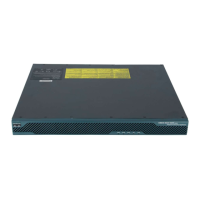Implementing Internet Key Exchange Security Protocol on Cisco IOS XR Software
How to Implement IKE Security Protocol Configurations for IPSec Networks
SC-50
Cisco IOS XR System Security Configuration Guide
Configuring Call Admission Control
These tasks are used to configure Call Admission Control (CAC):
• Configuring the IKE Security Association Limit, page SC-50
• Configuring the System Resource Limit, page SC-52
Configuring the IKE Security Association Limit
This task configures the IKE security admission limit.
SUMMARY STEPS
1. configure
2. crypto isakmp call admission limit {in-negotiation-sa number | sa number}
Step 3
pre-shared-key {address
address
[
mask
] |
hostname
hostname
} key
key
Example:
RP/0/RP0/CPU0:router(config-keyring)#
pre-shared-key address 10.72.23.11 key vpnkey
RP/0/RP0/CPU0:router(config-keyring)#
pre-shared-key hostname mycisco.com key vpnkey
Defines a preshared key for IKE authentication.
• Use the address keyword to specify the IP address of
the remote peer or a subnet and mask.
• (Optional) Use the mask argument to match the range of
the address.
• Use the hostname keyword to specify the fully
qualified domain name (FQDN) of the peer.
• (Optional) Use the key keyword to specify the key.
Step 4
end
or
commit
Example:
RP/0/RP0/CPU0:router(config-keyring)# end
or
RP/0/RP0/CPU0:router(config-keyring)# commit
Saves configuration changes.
• When you issue the end command, the system prompts
you to commit changes:
Uncommitted changes found, commit them before
exiting(yes/no/cancel)?
[cancel]:
–
Entering yes saves configuration changes to the
running configuration file, exits the configuration
session, and returns the router to EXEC mode.
–
Entering no exits the configuration session and
returns the router to EXEC mode without
committing the configuration changes.
–
Entering cancel leaves the router in the current
configuration session without exiting or
committing the configuration changes.
• Use the commit command to save the configuration
changes to the running configuration file and remain
within the configuration session.
Command or Action Purpose

